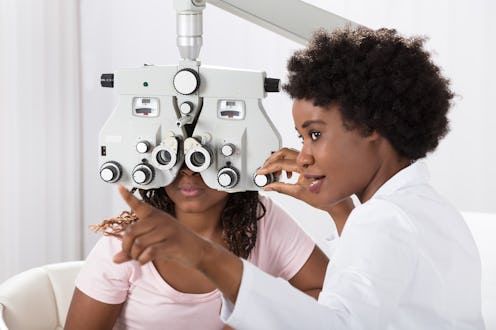Health
Why A Comprehensive Eye Exam Should Be First On Your Back-to-School List
How to stay on top of eye health for you and the whole family.

Stocking up on school supplies, buying new clothes (and having a place to wear them), scheduling a check-up with the doctor — after over a year of remote or hybrid learning, parents can once again experience the satisfaction of crossing things off their kids’ back-to-school lists. And while there’s undoubtedly excitement in returning to some semblance of normalcy, it’s also important to recognize and address the aftereffects of pandemic life, especially when it comes to your child’s eye health.
Studies have shown that myopia, or nearsightedness, has been on the rise in children for generations. Add to that the recent increase in screen time from remote learning, and there’s been an exacerbation in other eye issues as well, including eye strain, dry eyes, and eye focusing problems. The American Optometric Association, the leading authority on and advocate for quality eye health care, estimates that one in four children in the United States has a vision disorder requiring diagnosis and treatment from an optometrist specifically. That’s why it’s important to get ahead of your back-to-school to-do lists and book an appointment with an optometrist for your whole family to look after your eye health.
Healthy vision is correlated to success in the classroom & beyond
Vision issues aren’t isolated problems but instead affect almost every aspect of a child’s development, ranging from academics and athletics to social interactions and self-esteem. But without a comprehensive eye exam from an optometrist, many vision disorders may go undetected or, worse yet, may be misdiagnosed as ADHD, dyslexia, a learning disability, or a behavioral problem. These labels can then be carried into adulthood, further affecting an individual’s level of education, employment opportunities, and social interactions — without ever addressing the real underlying issue.
Eye exams go beyond testing for 20/20
Passing a vision screening in school is a great start, especially for children, but it doesn’t mean perfect vision or eye health. In fact, that common misconception can actually prevent the detection and treatment of a serious health condition that has been missed. If there’s been one positive to come out of the past year of remote learning, it’s that many parents have had the opportunity to gain insight into the ways their children learn. These observations have allowed parents to report whether their children experience symptoms like decreased focus, reduced comprehension, and headaches that are often signs of binocular vision anomalies (how your brain interprets signals from each eye).
An optometrist performing an in-person comprehensive exam can help identify more than 270 serious health conditions, including diabetes, high blood pressure, autoimmune diseases, and cancer. By using eye drops to dilate (widen) the pupils for a more complete view into the eyes, an optometrist can see blood vessels, and that can often identify signs of systemic disease, like hypertension and even brain tumors.
Early detection by an optometrist is key
The developing eyes of children, who are spending more time than ever in front of screens and devices, are more vulnerable to the symptoms of conditions that optometrists normally see in older adults. While early diagnosis and intervention of vision problems are essential for everyone, they’re especially critical for children, as they can become significantly worse over time if left untreated. Luckily, there’s an easy way to ensure your child’s healthy vision and overall eye health for the whole family: Schedule an in-person, comprehensive eye exam with an optometrist as part of your annual back-to-school routine. To learn more, visit AOA.org/EyeDeserveMore.